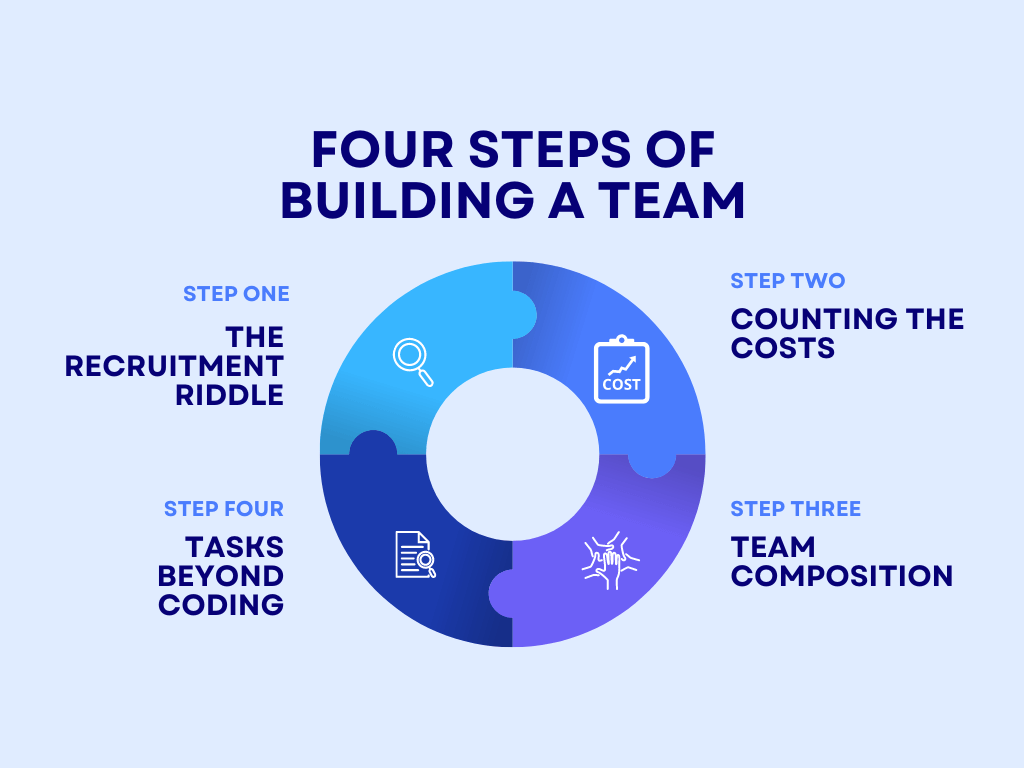Why Bootstrapping Your Dev Team Might Cost More Than You Think?
 Danubius IT Solutions
Danubius IT Solutions
The Allure and Illusion of In-House Development Teams
This article was originally published on Danubius IT Solutions' tech blog.
To many startups, the idea of having an in-house development team might sound like a dream come true.
Immediate access to talent, tight-knit collaborations, and a sense of control over the entire development process. But here's the thing, building and maintaining an efficient development team is no walk in the park. In fact, it's akin to renovating a room in your house – imagine buying thousands of dollars’ worth of machinery at an inflated price and then attempting the renovation yourself, roping in any willing family member or neighbor.
Sure, there's a sense of ownership, but would the result match the finesse of a professional?
A Closer Look: Building the Team

Let’s overview each aspect of recruiting a fully staffed and qualified in-house development team from the ground up.
The Recruitment Riddle
Pinpointing top-notch professionals feels much like searching for a singular needle in an expansive haystack. This challenge only amplifies with the increasing number of specialized roles a company requires.
Without well-established hiring channels, startups often find themselves paying a premium to headhunters to bridge the gap. This process becomes even more intricate when one considers the specialized knowledge needed to vet candidates effectively.
For instance, without a deep understanding of IT, how does one evaluate the prowess of a Java Developer or a DevOps Engineer? To provide a glimpse into the intricacies of the process, consider our own experience at Danubius: we struggled with recruiting the right Test Engineer, not because of a lack of talent, but because potential candidates sought a more vibrant professional tester community.
This illustrates a vital component of the hiring process: ensuring the alignment of the team with the company's overarching vision, growth trajectory and core mission.
Counting the Costs
Building an in-house team carries significant financial implications. Beyond the obvious expenses of salaries lie the hidden costs of recruitment, training, benefits, equipment, and the myriad other expenses associated with setting up and maintaining a team.
But the costs are not purely financial. Today's professionals seek more than a competitive salary. They desire a thriving environment that offers opportunities for learning, collaboration, and growth. Startups often find themselves at a crossroads: can they provide such a nurturing ecosystem?
Team Composition
Creating a balanced team goes beyond mere headcount. It necessitates a deep understanding of various roles and their unique contributions.
For those unfamiliar with the world of IT, differentiating between a frontend developer and a backend developer can be perplexing. This lack of clarity can be equated to a novice in football trying to select a championship-winning squad.
To draw a parallel from the world of architecture, consider how an architect plays a pivotal role in designing a building's blueprint but isn't required for the entire construction. Similarly, an IT architect's involvement might be intensive during the initial phases but not consistently throughout the project.
Tasks Beyond Coding
The journey of software development isn't confined to coding alone. The post-launch phase encompasses a spectrum of tasks like operation, support, patching, and maintenance.
This realisation often dawns late on many startups, leading to hasty, reactionary decisions. While coders are the heart of development, an entire brigade of support staff acts as its lifeblood, ensuring the software remains functional,updated, and user-friendly. The DevOps methodology helps these roles connect and provide business value together, but both kinds of work are mandatory to be successful.
Sadly, this expansive view of what truly entails 'development' is something many startups either overlook or under-allocate, often to their detriment.
With these complexities in mind, it becomes evident why building and maintaining an efficient development team is a monumental task, especially for startups.
From Team Assembly to Streamlined Functionality
Once a team is built, the real challenge begins: driving it towards common goals with efficiency and ensuring seamless collaboration.
Just like a well-oiled machine, every part needs to work in harmony, adhering to a shared vision. Here's a deeper look into the complexities involved in running a development team.
Efficiency and Work Organization
Understanding and adapting to your team's dynamics is pivotal. While retrospective discussions post-sprints might shed light on what went wrong or right, many startups fall into the trap of continuing without significant changes.
The need for radical methodological adjustments is often apparent, but executing them while managing other business aspects can be overwhelming.
The Crucial Bridge: Directing the Team from Management Vision to Development Execution
Startups need a translator – an individual who can decode management's objectives into technical directives. This role goes beyond mere communication; it's about insight and alignment.
Contrary to common misconceptions, an analyst isn't a luxury but a necessity. Their absence can lead to a chasm between business goals and development outcomes, with inexperience exacerbating this divide. Some of the best developers can take this role as their own, but these kind of product-minded developers are extremely rare, and if you could find one, stick to him or her.
The Roadmap: A Clear Path Forward
A well-defined roadmap provides the team with clarity and direction, detailing what will be implemented in upcoming phases. Understanding the bigger picture isn't just about project completion – it fuels internal motivation, shedding light on the functions and implications behind each task.
However, startups frequently falter by constantly shifting priorities. Imagine planning a journey for half a day, only to change the destination hourly. Not only is this inefficient and demotivating, but it also burns cash and diminishes ownership. Obviously, agile methodologies can support frequent changes and reactions to the market, but cannot be treated as a divine power.
The Essence of Ownership
True ownership implies standing by one's work, but constant revisions can diminish this sentiment. A developer might wonder: Why refine a requirement if it's likely to change? Retaining team members becomes a Herculean task in such an environment. And should someone leave, the cost of onboarding and integrating a newcomer can be exorbitant.
Team Dynamics and a Continuous Cycle
A team's journey often mirrors the stages of Storming, Forming, Norming, and Performing. The 'Performing' stage, where teams function optimally, is the desired destination. However, the introduction of a new member can reset this cycle, leading back to the 'Storming' phase. Even if regrouping is faster, it's an efficiency-draining process.
Retention
Every individual, from juniors to seniors, craves support and feedback. In an industry marked by constant evolution, mentorship is invaluable.
Fostering a culture of learning and camaraderie isn't just about retention; it's about creating an environment where innovation thrives and professionals feel valued. The promise of a competitive salary might lure talent, but it's the leader, the culture and the community that make them stay. With their vast experience, seniors look for a vibrant professional community, while younger developers often seek mentors to guide them through intricate development dilemmas.
In Conclusion
Establishing an in-house development team isn't merely about hiring the right candidates. It encompasses intricate processes, ranging from ensuring efficient work organization to providing consistent mentorship. Startups, in their pursuit of rapid growth, often overlook these nuances, leading to a chasm between their vision and the product delivered.
However, there's a viable solution that mitigates these challenges: collaboration with a seasoned partner that provides a fully ready, full-stack team.
So, why spend exorbitant amounts recruiting, training, and retaining an in-house team when you can get an experienced team for a fraction of the cost? Get in touch with Danubius and leverage the expertise of a fully-ready, full-stack team that aligns with your vision and propels your startup to new heights.
Subscribe to my newsletter
Read articles from Danubius IT Solutions directly inside your inbox. Subscribe to the newsletter, and don't miss out.
Written by

Danubius IT Solutions
Danubius IT Solutions
End-to-end software development from a pool of talented software engineers.